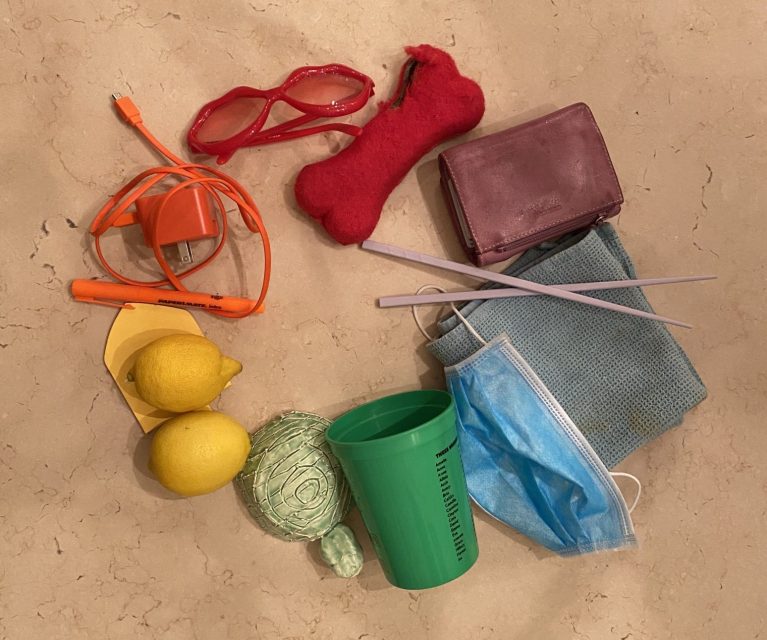Español abajo
Create your own 3D color wheel by collecting and arranging objects in your own house!

A color wheel is a tool used to show the relationships between colors. Red, blue, and yellow are called primary colors because they are the foundation for all of the other colors on the wheel. In fact, it is impossible to make primary colors by mixing together any other colors! Violet, green, and orange are called secondary colors because they are made by mixing two primary colors together. You can see that each secondary color is located in between the two primary colors that it consists of. Colors that are directly across from each other on the color wheel, like red and green, are known as complementary colors. Pairs like this are nice to look at when you use them together.
Instructions
Step 1: Find some space on the floor or on a table where you can lay out several objects in a circle.
Step 2: Look around your house and find as many objects as you can that are primary or secondary colors. With a parent or guardian’s permission, collect these items and bring them to your chosen area. Be creative – make sure you check every room that you are allowed to enter! Is there something in your closet? What about your refrigerator? Your sibling’s bathroom?
Step 3: Arrange your objects so that they form a color wheel. Use what you’ve just learned about primary, secondary, and complementary colors to place each object where you think it belongs.
Step 4: Take a moment to admire your creation. What do you think about the arrangement of the colors? Do you think the order they are placed in makes sense? See if you can spot anything in your house that seems to follow the rules of the color wheel.
Step 5: Clean up time! Make sure you put every item back where it belongs. Get help from a parent or guardian if you need it.
Step 6 (Optional): Try the scavenger hunt again with a new set of objects. Time how long it takes you. Can you beat your fastest record?
Vocabulary
Color wheel – artistic tool used to show the relationships between colors
Primary colors– colors that cannot be made by mixing other colors; red, blue, and yellow
Secondary colors – colors that are made by mixing together two primary colors; violet, green, and orange
Complementary colors – colors that are located across from each other on the color wheel and are visually pleasing when paired together; red and green, violet and yellow, blue and orange
SEE MORE FUN AT-HOME ACTIVITIES FOR KIDS ON OGDEN MUSEUM ONLINE!
QUESTIONS? EMAIL EDUCATION@OGDENMUSEUM.ORG.
______________________________________
Lunes de movimiento: Búsqueda del tesoro del círculo cromático
¡Crea tu propio círculo cromático 3D, recolectando objetos y ordenándolos en tu casa!

Un círculo cromático es una herramienta utilizada para mostrar las relaciones entre los colores. El rojo, el azul y el amarillo son colores primarios porque son la base de todos los otros colores del círculo. De hecho, ¡los colores primarios no se pueden hacer mezclando otros colores! El violeta, el verde y el naranja son colores secundarios porque se hacen mezclando dos colores primarios. Puedes ver que cada color secundario está ubicado en el medio de los dos colores primarios que lo componen. Los colores que se encuentran directamente enfrentados en el círculo, como el rojo y el verde, son colores complementarios. Estos pares de colores se ven bien cuando se utilizan juntos.
Instrucciones
Paso 1: Busca un lugar en el suelo o en una mesa donde puedas distribuir varios objetos en forma de círculo.
Paso 2: Busca en tu casa la mayor cantidad de objetos que puedas que sean de colores primarios o secundarios. Pídele permiso a un padre o tutor y recolecta estos objetos y llévalos a tu área de trabajo. ¡Sé creativo y asegúrate de buscar en todos los cuartos a los que se te permita entrar! ¿Hay algo en tu guardarropas? ¿Y en tu refrigerador? ¿En el baño de tu hermano o hermana?
Paso 3: Distribuye los objetos formando un círculo cromático. Utiliza lo aprendido sobre colores primarios, secundarios y complementarios para ubicar cada objeto donde pienses que corresponda.
Paso 4: Tómate un momento para admirar tu creación. ¿Qué piensas de la distribución de los colores? ¿Piensas que el orden en el que están ubicados tiene sentido? Fíjate si puedes identificar algún elemento en tu casa que siga las reglas del círculo cromático.
Paso 5: ¡Momento de ordenar! Asegúrate de regresar cada objeto a donde pertenece. Si lo necesitas, pídele ayuda a un padre o tutor.
Paso 6 (opcional): Realiza otra búsqueda del tesoro con nuevos objetos. Cronometra el tiempo que te lleva. ¿Puedes superar el récord más rápido?
Vocabulario
Círculo cromático: herramienta artística utilizada para mostrar las relaciones entre los colores.
Colores primarios: colores que no pueden ser creados mezclando otros colores. Son el rojo, el azul y el amarillo.
Colores secundarios: colores que se hacen mezclando dos colores primarios. Son el violeta, el verde y el naranja.
Colores complementarios: colores que se encuentran enfrentados en el círculo cromático y que se ven bien cuando se utilizan juntos. Son el rojo y verde, violeta y amarillo y el azul y el naranja.
¡VE MÁS ACTIVIDADES DIVERTIDAS PARA NIÑOS PARA HACER EN CASA EN OGDEN MUSEUM ONLINE!
¿PREGUNTAS? ENVÍA UN EMAIL A EDUCATION@OGDENMUSEUM.ORG.
Translation by Agostina Coll
